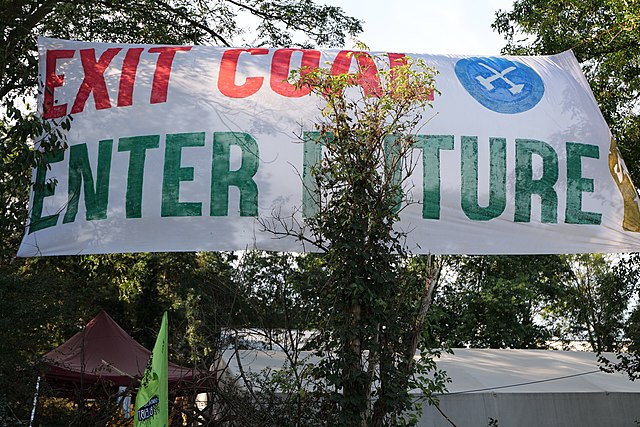September came to an end in Germany with the much lauded ‘Climate Election’ and a very sobering result. Early in the year the polls had shown a clear majority in favour of progressive parties. However the election results show that conservative, neoliberal and right wing parties retain substantial support, despite their lack of climate ambitions. As usual, Germans were anxious about too much change and voted for the better of two bad options. The Green party’s lead in the polls had melted away in the weeks leading up to the election, the Left party (die Linke) almost failed to get into parliament at all, and meanwhile the far right once again received their reliable share of the vote.
It is to the credit of the numerous groups that make up the climate justice movement that the climate issue had become so important in this election campaign. Fridays for Future have been striking tirelessly for nearly three years; lignite mines, forests and car industry exhibitions have been occupied as part of ongoing civil disobedience movement; and on a local level many people are organizing themselves into local climate protection initiatives. In surveys of the general public, climate is now always named as the most important issue we face.
The climate justice movement in Germany has become versatile and powerful in recent years, and its voices have become an integral part of the political discourse. However, the election results clearly indicate that its strategies and plans must now change.
Climate Action? Unfortunately they missed the point
To understand why the election result is such a disappointment from a climate perspective, and why the movement must redirect itself, we first need to look back at the election campaign. In the run up to the election, climate change was at the top of the media agenda; however, the political discourse fell far short. Fighting climate change was primarily presented as a financial issue and the question was posed time and again: ‘What would climate action cost and how does your party suggest we pay for it?’. As a result, the much more pressing question was never asked: ‘What will it cost us financially, but also socially, politically and existentially, if we do not take action on climate change?’ Can we afford to not take action on climate change, or to do too little, at the expense of future generations? And what does that actually mean for our children and grandchildren?
Secondly, throughout the campaign climate policy was framed as a punitive debate on what people should and shouldn’t do. ‘Will we soon not be allowed to own a car?’ ‘Can we still go on holiday to Mallorca?’ ‘How many steaks will your party allow me to eat?’ Instead of discussing the most necessary social and political transformation project of all time, the discussion was reduced to the ways in which regulatory policy should limit individuals’ behaviour. Climate action was associated only with sacrifice and not with the chance to transform our society to become fairer and more sustainable.
These debates diverged greatly from the goal of climate action and the demands of the climate justice movement. It’s unsurprising, in this context, that the Social Democratic Party (SPD) Chancellor candidate Olaf Scholz was presented as the ‘Climate Chancellor’, despite his proposed withdrawal from coal mining by 2038, when there is unanimous scientific consensus that this would be far too late to meet the goals set by the Paris Climate Agreement. Armin Laschet, the Chancellor candidate for the conservative Christian Democratic Union (CDU) was also pandering to calls for climate action. However, when faced with the catastrophic flooding in his own state North Rhine-Westphalia, he declared: ‘today is not the day to discuss changes to political policy’. Meanwhile, the Green Party candidate Annalena Baerbock was always on the defensive both personally and politically and faced constant sexist attacks. But through her constant repetition of buzzwords like “awakening” and “change”, she missed the opportunity to make a rousing and convincing case for climate action. Meanwhile, die Linke tried to concentrate on its core issue of social justice but stumbled rather awkwardly through the climate debates, in which the party leaders made statements completely contrary to their own manifesto. Ultimately, it was not made clear why one should actually vote for them at all.
Even before the election campaign, it was clear that none of the parties had a program that could meet the Paris climate target of limiting global heating to 1.5 degrees Celsius above pre-industrial levels. So it was already evident before the election results came in that the climate justice movement would not be represented by any party in parliament. Climate may have been the number one issue of the campaign, but despite all the protests, all the occupations, all the public appeals and legal challenges, climate action was not an electable issue.
The ‘Climate coalition’ and the ideology of digital green growth
At this stage, coalition negotiations are still taking place, but it is quite clear that a new government will be made up of a ‘traffic light coalition’ led by the SPD, with the Greens and Free Democrats (FDP) as junior partners. So what exactly does this mean for climate protection? First of all, one could optimistically state that climate protection is important to all three parties and that they hold it up at least as a metaphorical fig leaf. It will not simply be a matter of making a commitment to climate action either. Since a historic ruling by the Federal Constitutional Court in April, the German government is already legally required to significantly increase their ambitions on tackling climate change.
What will become important during the coalition negotiations is what the parties involved actually understand by ‘climate action’ and what measures they will and won’t push for. The following roles are most probable in the traffic light coalition: The SPD will be the biggest barrier to climate action since it typically puts the interests of workers in the fossil fuel industry, as well as banks and corporations, first. As the Greens want to hit the ground running, they will probably start by ambitiously putting a number of climate protection proposals and measures on the table. The FDP will predictably play for time. Instead of tangible policies it will propose vague notions of “innovations” and “digital technologies” that it believes will get us out of the climate crisis.
That may be a simplification, but we might end up backed up behind a traffic light that refuses to turn green.
There is also another very real danger. While all parties can rhetorically agree on more climate protection, the FDP and the pragmatic wing of the Greens will be joined by technophiles and political technocrats who love technology and the catchphrase: ‘a growing green and digitized economy.’ Green and digital solutions are the great promise of salvation. We can continue to do business and live the same way with magically less emissions. This green growth ideology has been around for years and has delivered less-than-successful results. The global economy continues to grow and become more digital and green, but neither emissions nor resource consumption are falling.
Instead, we have global temperatures rising far too fast, widespread biodiversity loss, and deepening social divisions worldwide. Empirically, new and efficient technologies do not lead to less resource use; in the worst cases, they actually lead to more. Nevertheless, a traffic light coalition will mainly rely on exactly this old wives’ tale as a promising climate measure, with dramatic implications for the climate.
So in the end, it could well be that the concept of climate protection will itself lead to very few controversies, and that the negotiating parties will be able to agree on it very quickly. The commitment to more climate protection could even become the glue that holds the coalition together. Especially if it is combined with promises of more business, more technology and, above all, more growth. After all, this sounds just as optimistic as it is meaningless and ineffective, and requires hardly any political sacrifice from the co-ruling parties.
For the climate justice movement, however, it is clear that climate protection can not be achieved by increasing the number of electric cars, nor by capturing CO2 from the atmosphere, nor with emissions trading or autonomous air cabs. But this also means that the resistance to these new climate policies will have to be organized differently from now on.
New strategies and struggles
If the new German government, in contrast to the Merkel years, is much more committed to climate protection and is at least, on paper, moving in the direction of the demands of the climate movement, then the climate movement must also change. Although the Green Party is now part of the government this will not lead to significant change. The climate movement is therefore not going to become less important. Quite the opposite. Precisely because climate justice cannot be achieved with purely technological and digital innovations, strong social movements are needed more than ever to point out these gaps and contradictions. It will be up to the young people at the demonstrations and occupations to highlight the inadequacies of these measures and demand a rethink. This will also require a rethinking of their own strategy. Many groups like Fridays for Future have so far committed themselves to continuing their current strategy, in an almost naïve hope that if they carry on protesting, their demands will eventually be listened to by politicians. Appeals alone, however, will no longer suffice. Instead, the climate movement must credibly and intelligently justify why green capitalist measures are insufficient and will only exacerbate our problems. They must explain why a comprehensive transformation rather than a green coat of paint is needed across the board. This task is much more difficult to accomplish than a strategy of cautious warnings that many have pursued so far.
Of course, the climate movement will always find its places of resistance and hope. At the moment, attempts are still being made to save the village of Lützerath from the coal excavators, which also puts a much earlier coal phase-out back on the political agenda. There will also be forest occupations again when new motorways are planned, just as there will be the Friday school strikes. But for a comprehensive critique of green growth climate protection policies, it will no longer suffice to highlight the same scandals in different locations over and over again.
Therefore, long-term plans are needed now for the time after the “climate campaign”, after the occupations, after the mass actions and after the strikes.
There are several possible scenarios. It is likely that many activists will soon withdraw from activism altogether. Some will accept the tiny success of the government but most will be bitterly disappointed in unachieved goals. Nevertheless, large numbers of young people in particular are now highly politicized and are committed to continuing the fight. They may decide to reform the more progressive parties from within, or form alternatives to them, in an attempt to give the climate movement genuine representation. Although the new Klimaliste party has already predictably failed in this attempt, new projects could still attract activists. Further development and escalation of the previous civil disobedience strategies is also conceivable. Many activists are already considering ways to disrupt the destructive fossil and green capitalist system. It is likely that some parts of the climate movement will become much more radicalized and begin new methods and tactics to galvanize radical climate action.
Last but not least, there is the question of the extent to which the previous struggles can also be developed and expanded. Because real climate protection can only be achieved with climate justice, and that in turn requires a comprehensive social transformation, not just changes in energy production. It also means changing the way we work, where and how we live, how we get around, what we eat, and how we communicate with each other. This requires struggles throughout society, along the lines of the plaza occupations in Spain or the recent movement to change the constitution in Chile. The climate movement must also link local concerns with global justice in order to have a truly transformative effect on society. The next few years under a traffic light coalition will show if the climate movement can succeed in initiating precisely this revolution in our society.
This article was written in German for theleftberlin.com. Translation; Alice Lambert




